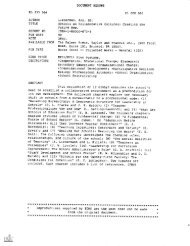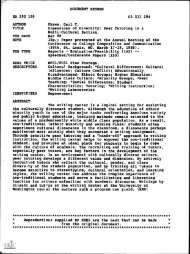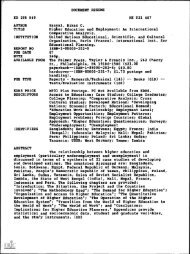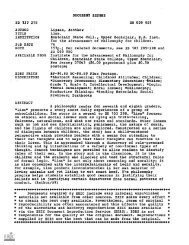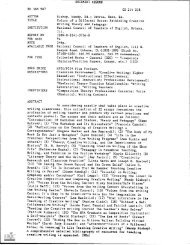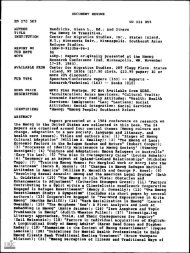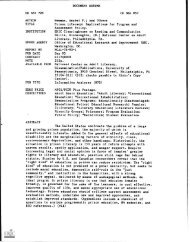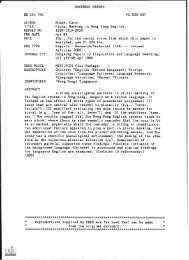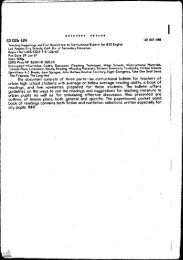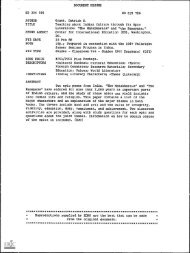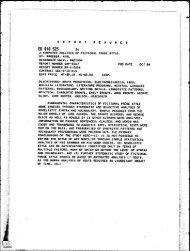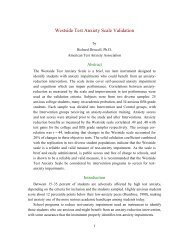Unlearning Colorblind Ideologies in Education Class - ERIC
Unlearning Colorblind Ideologies in Education Class - ERIC
Unlearning Colorblind Ideologies in Education Class - ERIC
Create successful ePaper yourself
Turn your PDF publications into a flip-book with our unique Google optimized e-Paper software.
Jung-ah Choi<strong>Education</strong>al Foundations, Summer-Fall 2008<strong>Unlearn<strong>in</strong>g</strong><strong>Colorbl<strong>in</strong>d</strong> <strong>Ideologies</strong><strong>in</strong> <strong>Education</strong> <strong>Class</strong>By Jung-ah ChoiJung-ah Choi is a professorwith the College of <strong>Education</strong>at Governors State University,University Park, Ill<strong>in</strong>ois.Journalist Ellis Cose (1993) cogently writes,“Racial discussions tend to be conducted at one of twolevels—either <strong>in</strong> shouts or <strong>in</strong> whispers. The shouters aregenerally so twisted by pa<strong>in</strong> or ignorance that spectatorstune them out. The whisperers are so afraid of the st<strong>in</strong>gof truth that they avoid say<strong>in</strong>g much of anyth<strong>in</strong>g at all”(p. 9). This quote resonated with me. While teach<strong>in</strong>gabout racism and racial issues, I have often pondered:why is it so difficult to talk—not shout or whisper—aboutrace and racial issues <strong>in</strong> academic sett<strong>in</strong>gs? This questionhas been grappled with by a number of researchersand teacher educators (Goodman, 1998; Ladson-Bill<strong>in</strong>gs,1996; Nieto, 1998; Tatum, 1997, to name a few)who use Critical Race Theory (Ladson-Bill<strong>in</strong>gs, 1997;Ladson-Bill<strong>in</strong>gs & Tate, 1995) or Critical White studies(Marx, 2003; Scheurich, 1993; see also Sheets, 2000) tochallenge liberal discourses about racism, to <strong>in</strong>terrogatethe system of racial oppression, power, and privilege.Critical Race Theory and Critical White studies havebeen <strong>in</strong>troduced as part of teacher preparation programsand have <strong>in</strong>formed critical multicultural education by53
54<strong>Unlearn<strong>in</strong>g</strong> <strong>Colorbl<strong>in</strong>d</strong> <strong>Ideologies</strong>allow<strong>in</strong>g prospective teachers to exam<strong>in</strong>e curriculum and pedagogy <strong>in</strong> relation to<strong>in</strong>stitutional racism. Critical multicultural education poses a paradigmatic challengeto liberal discourse on race, i.e., colorbl<strong>in</strong>d ideology. For example, critical multiculturaleducation br<strong>in</strong>gs the significance of race to the fore <strong>in</strong> its analysis of socialrelations (K<strong>in</strong>g, 1991; Ladson-Bill<strong>in</strong>gs, 1997; Lewis, 2001; Sleeter, 1996) whereasliberal discourses tend to disguise racial <strong>in</strong>equality by employ<strong>in</strong>g the rhetoric ofequal opportunity and fair treatment. Critical educators, particularly Critical Racepedagogues, critique colorbl<strong>in</strong>d ideology as tantamount to racism because it servesto ma<strong>in</strong>ta<strong>in</strong> racial <strong>in</strong>equality. K<strong>in</strong>g (1991), for example, refers to colorbl<strong>in</strong>dness as“dysconscious racism” s<strong>in</strong>ce colorbl<strong>in</strong>d ideology susta<strong>in</strong>s and justifies the cultureof power (see also, Delpit, 1988). <strong>Colorbl<strong>in</strong>d</strong> ideology constitutes a new racism <strong>in</strong>the era of political correctness and free market <strong>in</strong>dividualism (Bonilla-Silva, 1997;Carr, 1997). Gordon (2005) writes, “<strong>Colorbl<strong>in</strong>d</strong>ness is a bid for <strong>in</strong>nocence, an attemptto escape our responsibility for our White privilege. By claim<strong>in</strong>g <strong>in</strong>nocence,we reconcile ourselves to racial irresponsibility” (p. 143).Sociologists (Bonilla-Silva, 1997; Feag<strong>in</strong>, 1993; Frankenberg, 1993) alsopo<strong>in</strong>t out the pervasiveness of colorbl<strong>in</strong>d ideology <strong>in</strong> White people’s perspectivesand attitudes. Bonilla-Silva’s book, Racism without Racists, conta<strong>in</strong>s an extensiveexploration of the rhetorical devices of colorbl<strong>in</strong>dness, argu<strong>in</strong>g that colorbl<strong>in</strong>dnessis manifest <strong>in</strong> several ideological threads present <strong>in</strong> discursive spaces: abstract liberalism(“affirmative action is unfair to White people”); naturalization (segregationis natural); cultural racism (“Mexicans do not put much efforts <strong>in</strong>to education”);and m<strong>in</strong>imization of race (“racism is a th<strong>in</strong>g of the past”). Tatum (1994) expla<strong>in</strong>sthat such colorbl<strong>in</strong>d reactions as “I am not a racist,” “I am not comfortable talk<strong>in</strong>gabout race,” and “I do not have stereotypes or prejudices” occur at the early stageof White racial development (p. 404). In this early stage, which Tatum (1994) callsthe “contact stage.” Whites rarely describe themselves as a part of a racial groupand pay little attention to other races (p. 404).<strong>Education</strong>al researchers and teacher educators document <strong>in</strong>stances <strong>in</strong> whichdiscussions about race and racism have engendered opposition and resistancewith<strong>in</strong> White pre-service teachers (Case & Hemm<strong>in</strong>gs, 2005; Chavez, Chavez, &O’Donnell, 1998; Hytten & Warren, 2003; Solomon et al., 2005). Ladson-Bill<strong>in</strong>gs(1994) describes her own encounters with the rhetoric of colorbl<strong>in</strong>dness:My own experiences with White teachers, both pre-service and veteran, <strong>in</strong>dicate thatmany are uncomfortable acknowledg<strong>in</strong>g any student differences and particularlyracial differences. Thus some teachers make such statements as “I don’t really seecolor. I just see children.” Or “I don’t care if they were red, green, or polka dot. Ijust treat them all like children” (p. 31)Teach<strong>in</strong>g racial issues to advocates of colorbl<strong>in</strong>d ideology or to contact-stageWhites can be particularly challeng<strong>in</strong>g because exposure to issues of oppression,<strong>in</strong>stitutional racism, and power makes “color” visible and thus forces White studentsto face their White identity and White privilege (Cochran-Smith, 1995; Lawrence& Tatum, 1997; McIntyre, 1997; Tatum, 1994, 1997). Also, when their colorbl<strong>in</strong>d
Jung-ah Choiideology is challenged, White pre-service teachers often assume a defensive position(Roman, 1993; Goodman, 1998). The emergence of Critical White Studiesaddresses the fact that many White students lack <strong>in</strong>terest <strong>in</strong> racial issues and callsfor engagement <strong>in</strong> race discourse. Critical White Studies (e.g., McIntosh, 1998)embraces the White audience more directly by emphasiz<strong>in</strong>g the ideology of Whiteness,i.e., what it means to be White, and what it means to be a colorbl<strong>in</strong>d teacher<strong>in</strong> this society. Critical White Studies moves beyond the colorbl<strong>in</strong>d stance and helpsWhite teachers to explore their racial identity by confront<strong>in</strong>g the racialness of theWhite experience (Frankenberg, 1993).My first encounter with colorbl<strong>in</strong>d rhetoric <strong>in</strong> education classes is an embarrass<strong>in</strong>gyet transformative memory. Years ago, I, as an Asian female faculty member,taught an education class <strong>in</strong> a predom<strong>in</strong>antly White <strong>in</strong>stitution. The class, which wasrequired of all pre-service teachers, was designed to discuss racism and other formsof oppression <strong>in</strong> the context of education. We read an excerpt of The Dreamkeepers:Successful Teachers of African American Children (Ladson-Bill<strong>in</strong>gs, 1994), one ofthe most widely read books <strong>in</strong> multicultural education. The book critiqued the “Idon’t see color, I just see children” attitude and developed a theory of culturallyrelevant teach<strong>in</strong>g. When I asked my students to express their <strong>in</strong>itial reactions toLadson-Bill<strong>in</strong>gs’s contentions, one of the students remarked assertively, “Teachersshould not stereotype race. See<strong>in</strong>g color <strong>in</strong> children is like stereotyp<strong>in</strong>g.” Anothersimilar comment followed: “Teachers shouldn’t give differential treatment basedon race.” Immediately after this student’s comment, a majority of students <strong>in</strong> theclassroom consented, either audibly or <strong>in</strong>audibly. I was totally at a loss <strong>in</strong> f<strong>in</strong>d<strong>in</strong>g aconstructive response to this comment because their claims made perfect sense <strong>in</strong>their own way. The claim that teachers should not have stereotypes about certa<strong>in</strong>races is completely valid, although, paradoxically, this claim is what Ladson-Bill<strong>in</strong>gscritiques. In retrospect, I should have been more prepared, s<strong>in</strong>ce this l<strong>in</strong>e ofcommentary recurs almost every time a discussion on race and teach<strong>in</strong>g occurs.This experience engendered numerous questions and quandaries. The colorbl<strong>in</strong>drhetoric expressed <strong>in</strong> the education classroom disturbed me <strong>in</strong> a way that I couldnot fully expla<strong>in</strong>. What is it about colorbl<strong>in</strong>d rhetoric that garners such publicacceptance? What should I have said <strong>in</strong> reaction to my students’ attitude towardscolorbl<strong>in</strong>dness? What read<strong>in</strong>g should I have assigned <strong>in</strong> order to debunk colorbl<strong>in</strong>dideology? Should I debunk it at all? Where did they learn this value and why dothey <strong>in</strong>ternalize it so deeply? Are colorbl<strong>in</strong>d attitudes always wrong? If not, <strong>in</strong> whatcontext does colorbl<strong>in</strong>d ideology work? In order to solve my quests, I had to delve<strong>in</strong>to colorbl<strong>in</strong>d ideology, and that exploration became the genesis of this article.As an attempt to unpack the colorbl<strong>in</strong>d model that so many pre-service teachersendorse, I made the most of my own teach<strong>in</strong>g experience as a teacher educator,reflect<strong>in</strong>g analytically on classroom discussions and student reactions. Accuratelyspeak<strong>in</strong>g, the reason I was frustrated with colorbl<strong>in</strong>d attitudes was not because thestudents presented a different political stance than my own, but rather because my<strong>in</strong>ability to answer student questions h<strong>in</strong>dered me from accomplish<strong>in</strong>g my pedagogical55
56<strong>Unlearn<strong>in</strong>g</strong> <strong>Colorbl<strong>in</strong>d</strong> <strong>Ideologies</strong>goal, which was to promote critical th<strong>in</strong>k<strong>in</strong>g skills by challeng<strong>in</strong>g their habits andpreconceptions about race. What I found most vex<strong>in</strong>g was that colorbl<strong>in</strong>d ideologyseemed so well-<strong>in</strong>tentioned that it was hard to fight aga<strong>in</strong>st. Apparently, I was notalone: <strong>in</strong> scholarly journals, I located the stories of a number of teacher educatorswho struggled to problematize liberal discourse <strong>in</strong> their classrooms. Also, I collectedfirst-hand <strong>in</strong>terview data by talk<strong>in</strong>g with teacher educators (my colleagues) who havetaught multicultural issues. These <strong>in</strong>terviews were conducted <strong>in</strong> a dialogue formatrather than as structured, formal <strong>in</strong>terviews, and these dialogues occurred as the<strong>in</strong>terviewed <strong>in</strong>structors and I casually talked about our dilemmas and quandaries.This study thus <strong>in</strong>corporates the spirit of the self-study method <strong>in</strong> the sense that itemerged from my own quandary and that my goal was to improve teacher educationpractices, <strong>in</strong>clud<strong>in</strong>g my own. The self-study has ga<strong>in</strong>ed <strong>in</strong>creas<strong>in</strong>g legitimacy andpopularity dur<strong>in</strong>g the last ten years as a methodological stance <strong>in</strong> teacher education(Cochran-Smith, 1999; Zeichner, 1999; see also Bullough & P<strong>in</strong>negar, 2001). Frommy <strong>in</strong>terviews and scholarly articles, I gleaned a multitude of <strong>in</strong>formation aboutthe colorbl<strong>in</strong>d rhetoric that propels pre-service teachers’ beliefs on education andrace. In the follow<strong>in</strong>g sections of this paper, I identify the ideological constructsof colorbl<strong>in</strong>d rhetoric.Ideological Underp<strong>in</strong>n<strong>in</strong>gs of <strong>Colorbl<strong>in</strong>d</strong>nessAccord<strong>in</strong>g to the liberal discourse that has developed <strong>in</strong> the post-Jim Crow era,a good citizen is colorbl<strong>in</strong>d. Likewise, the prototype of a good teacher has been constructedaround the ideal of colorbl<strong>in</strong>dness, and this ideal is manifest <strong>in</strong> commentssuch as, “I do not have stereotypes or prejudices,” or “Everyone deserves an equalchance.” This article contends that these colorbl<strong>in</strong>d ideologies work to disguise theracial privilege embedded <strong>in</strong> educational <strong>in</strong>stitutions. What norms underlie colorbl<strong>in</strong>dbeliefs? And how does critical multicultural education respond to specific forms ofcolorbl<strong>in</strong>dness? I collected the classroom discourse by <strong>in</strong>terview<strong>in</strong>g eight raciallydiverse teacher educators and analyz<strong>in</strong>g their stories <strong>in</strong> a way that illum<strong>in</strong>ates theirphilosophical and ideological grounds. As a result, I classified colorbl<strong>in</strong>d rhetoric <strong>in</strong>tofive ideological constructs: the apprenticeship model, the nationalistic/ assimilationiststance, the deficit perspective, meritocratic belief, and the neoliberal /postmodernistframework. The follow<strong>in</strong>g details these five constructs.a. Apprenticeship Model of “Learn<strong>in</strong>g to Teach” as <strong>Colorbl<strong>in</strong>d</strong> IdeologyMost pre-service teachers expect to learn teach<strong>in</strong>g skills and discipl<strong>in</strong>e techniques<strong>in</strong> education classes (Holt-Reynolds, 1992; Joram & Gabriele, 1998; Kagan,1992). All the teacher educators that I <strong>in</strong>terviewed observed that pre-serviceteachers assume that teacher education <strong>in</strong>volves learn<strong>in</strong>g <strong>in</strong>structional techniques.This depoliticization of the act of teach<strong>in</strong>g is based on the idea that there is a setof neutral knowledge that all students need to know and that there is a s<strong>in</strong>gle idealpedagogy that can be applied to all students. With<strong>in</strong> this framework, which iscalled the “apprenticeship model” (Britzman, 1986), the role of teacher education
Jung-ah Choiis m<strong>in</strong>imized to the teach<strong>in</strong>g of <strong>in</strong>structional strategies. The apprenticeship model,which has been a default mode of teacher education, <strong>in</strong>volves learn<strong>in</strong>g to teach bydo<strong>in</strong>g and, <strong>in</strong> most cases, by imitat<strong>in</strong>g teachers. The apprenticeship model privilegesaccumulated knowledge over the learner, dim<strong>in</strong>ish<strong>in</strong>g the cultural resources thatthe learner br<strong>in</strong>gs to the classroom. This assumption of teacher education justifiescolorbl<strong>in</strong>d ideology.Britzman (1986) critiques the apprenticeship model for its lack of <strong>in</strong>tellectualism.My own teach<strong>in</strong>g experience and the <strong>in</strong>terviewed teacher educators’ experiencesdemonstrated pre-service teachers’ predilection toward practicality, devalu<strong>in</strong>g<strong>in</strong>tellectualism. The students generally display more eagerness to learn solutions toracism than to raise questions about <strong>in</strong>stitutional racism. In their research on howto engage Whiteness, Hytten and Warren (2003) po<strong>in</strong>t out that White pre-serviceteachers tend to grow impatient when <strong>in</strong>structors try to just talk about racial issueswithout propos<strong>in</strong>g solutions. They characterize White students’ <strong>in</strong>terest <strong>in</strong> f<strong>in</strong>d<strong>in</strong>gsolutions to racism as a missionary-like zeal to make changes. The practicalorientation toward multicultural education is captured <strong>in</strong> one student’s comment<strong>in</strong> my education class: “This [<strong>in</strong>formation about multicultural education] will begood <strong>in</strong>formation if I teach <strong>in</strong>ner-city kids, but I am not plann<strong>in</strong>g on teach<strong>in</strong>g <strong>in</strong>the <strong>in</strong>ner-city.” Tellz and O’Malley’s (1998) <strong>in</strong>teraction with pre-service teacherscaptures the same attitude: “multicultural education was someth<strong>in</strong>g to ‘get through,’‘a waste of time’ that failed to explore the real world of teach<strong>in</strong>g” (p.169).The expectations raised by apprenticeship-based teacher education h<strong>in</strong>der one’sability to see education as a potential agent for empowerment and social change(Giroux & McLaren, 1986; Sleeter, 1996). While the apprenticeship model presupposesthat school is an assimilationist agency where young students learn knowledgeand skills generated by experts and established social norms and standards,Critical Race pedagogues critique the very norms and standards <strong>in</strong> terms of theirracialness. Under the apprenticeship framework, a teacher candidate only has tolearn the teach<strong>in</strong>g skills necessary to effectively transmit knowledge and skills. Incontrast, critical multicultural education questions the asymmetrical power relationsembedded <strong>in</strong> “norms,” “standards,” and “curriculum;” and forefronts the racialnessof what appears to be neutral. Therefore, critical multicultural educators denouncethe apprenticeship model for its colorbl<strong>in</strong>d nature. When race discourse is situated<strong>in</strong> the apprenticeship model, it is often structured <strong>in</strong> a way that emphasizes m<strong>in</strong>oritystudents’ underachievement and presupposes that a teacher’s role is to “help”m<strong>in</strong>ority students perform well on standardized tests. A discussion that presentstips for teach<strong>in</strong>g m<strong>in</strong>ority children without exam<strong>in</strong><strong>in</strong>g the school’s relationship tosystemic <strong>in</strong>equality often relies upon the deficit model, which will be discussedlater <strong>in</strong> this article.The premise of critical multiculturalism is that the school <strong>in</strong>stitution plays amajor role <strong>in</strong> perpetuat<strong>in</strong>g and re<strong>in</strong>forc<strong>in</strong>g White dom<strong>in</strong>ance and White privilege.Lisa Delpit’s (1988) sem<strong>in</strong>al article, “Silenced Dialogue,” provides <strong>in</strong>sights <strong>in</strong>tohow school’s hidden norms, such as <strong>in</strong>terpersonal codes, operate under White cul-57
<strong>Unlearn<strong>in</strong>g</strong> <strong>Colorbl<strong>in</strong>d</strong> <strong>Ideologies</strong>tural norms, l<strong>in</strong>guistic expectations, and logic. Accord<strong>in</strong>g to Delpit, a person wholearns to teach without conduct<strong>in</strong>g a serious critical assessment of these norms will<strong>in</strong>advertently comply with this form of White dom<strong>in</strong>ance. Delpit urges educators toexam<strong>in</strong>e the “silenced dialogue” that exists with<strong>in</strong> the school sett<strong>in</strong>g and to be awareof the historical, social, and political conditions <strong>in</strong> which school <strong>in</strong>stitutions favor acerta<strong>in</strong> group of people. For example, the dom<strong>in</strong>ant discourse of professionalism isembedded with White ideology. Under normative discourse, “treat<strong>in</strong>g all studentsequally” is deemed professional and fair, and advocat<strong>in</strong>g for any particular groupis construed as unprofessional or practic<strong>in</strong>g favoritism (Brandon, 2003; Tarca,2005). However, Critical Race pedagogues, like Ladson-Bill<strong>in</strong>gs (1994), questionthis norm, argu<strong>in</strong>g that treat<strong>in</strong>g all students <strong>in</strong> the same way and neglect<strong>in</strong>g racialdisparities ends up marg<strong>in</strong>aliz<strong>in</strong>g racial m<strong>in</strong>orities who have only limited accessto resources. As the open<strong>in</strong>g vignette shows, Ladson-Bill<strong>in</strong>gs’ position was metwith resistance <strong>in</strong> many teacher education classes. The teacher educators that I<strong>in</strong>terviewed all confirmed that their students were uncomfortable with the conceptof see<strong>in</strong>g color or mak<strong>in</strong>g judgments based on race and that they questioned thevalidity of such approaches.The apprenticeship model exalts field-based experience over the <strong>in</strong>tellectualvalue of teacher education. In Joram and Gabriele’s (1998) research, they captureone student comment that reflects this attitude: “University courses have little tooffer prospective teachers. I should be out <strong>in</strong> the field” (p.179). Similar commentsrecurred across all my <strong>in</strong>terviewees. I have heard pre-service teachers say that theycan’t wait to go out and teach <strong>in</strong> a real situation. These comments are steeped <strong>in</strong>the apprenticeship model’s behavioristic assumption that learn<strong>in</strong>g occurs throughimitation and repetition (Britzman, 1986). Concurr<strong>in</strong>g with Britzman’s critique ofthe apprenticeship model, Johnston (1994) argues that the experience of teach<strong>in</strong>g<strong>in</strong> the real classroom does not always become a learn<strong>in</strong>g experience; rather, itcan sometimes be just an experience. In his critique of the apprenticeship model,Labaree (1996) argues that curriculum of education schools lacks academic rigorand thus occupies a lowly status <strong>in</strong> the academic hierarchy. He laments that teachereducation curriculum is geared towards “do<strong>in</strong>g” rather than “th<strong>in</strong>k<strong>in</strong>g” (see alsoMandzuk, 1996), and towards applied discipl<strong>in</strong>e rather than pure discipl<strong>in</strong>e (Labaree,1996). The apprenticeship model is consistent with the K-12 school normwhere compliance and docility are valued over creative and critical th<strong>in</strong>k<strong>in</strong>g (foran extended discussion of this, see Mandzuk, 1996). The apprenticeship modelpositions the university—K-12 relationship as hierarchical, and this assumed hierarchybecomes a hidden curriculum of the teacher education curriculum, and <strong>in</strong>turn places the pre-service teachers and their students <strong>in</strong> a hierarchical relationship.Critical pedagogy’s egalitarian view, i.e., its belief that teachers and students areequal <strong>in</strong>tellectuals who both have the agency of reflective th<strong>in</strong>k<strong>in</strong>g, problematizesthis hierarchical assumption of the apprenticeship model.58
Jung-ah Choib. Nationalistic and Assimilationist View as <strong>Colorbl<strong>in</strong>d</strong> Ideology“Aren’t we all Americans, no matter what race?” This view is a classic exampleof colorbl<strong>in</strong>d rhetoric. The stance is well captured <strong>in</strong> my student response to videoclips from Color of Fear (Lee, 1994) where people of color self-identified by usedmodifiers before “American” such as, “I am African-American” or, “I am Mexican-American.” My White students wondered why people of color cannot claim to be‘just American’ and commented, “Once they are born here they have to say ‘I am anAmerican.’” Another of my students said that she is so proud of be<strong>in</strong>g an Americanand that they (m<strong>in</strong>orities) should feel proud too. Critical Race Theory proclaimsthat nationalistic ideology often marg<strong>in</strong>alizes racial/ethnic m<strong>in</strong>orities because nationalisticrhetoric <strong>in</strong> the United States is <strong>in</strong> sync with the logic of assimilationism,which <strong>in</strong>sists that m<strong>in</strong>orities should be ma<strong>in</strong>streamed <strong>in</strong>to the majority’s way of life.Rosaldo (1993) notes that <strong>in</strong> a society where m<strong>in</strong>ority groups feel marg<strong>in</strong>alized,nationalism is the disguise of cultural stripp<strong>in</strong>g, requir<strong>in</strong>g all citizens to be racelessand disembodied. In the field of education, m<strong>in</strong>ority children’s alienation anddisengagement <strong>in</strong> school support Rosaldo’s assertion. This logic of assimilationismis prevalent among college students. A Lat<strong>in</strong>o student cited <strong>in</strong> Lewis, Chelser, andForman’s (2000) study said, “People tell me, ‘You’re American! Speak English,damn it!’” Arguably, these angry comments def<strong>in</strong>e speak<strong>in</strong>g English as a criticalcondition of be<strong>in</strong>g American. This is rem<strong>in</strong>iscent of the follow<strong>in</strong>g comment fromone of my own students: “If I go to Germany, I will have to learn to speak the Germanlanguage and adopt a German life style. If they [immigrants] refuse to learnthe American way and stick to their ethnic way, why did they come to America?”While the formation of nationalistic and assimilationist logic constitutes a colorbl<strong>in</strong>dideology, Critical Race Theory uses m<strong>in</strong>ority people’s counter-story tell<strong>in</strong>gto racialize the discourse of nationalism <strong>in</strong> the United States. Multicultural educatorJames Banks (1991) writes that textbooks are embedded with Eurocentric ideology,which “results <strong>in</strong> Anglo immigrants to the West be<strong>in</strong>g called ‘settlers’ rather than‘immigrants’ … call<strong>in</strong>g the Americas the New World subtly denies the nearly fortythousand years that Native Americans have lived <strong>in</strong> this land” (p. 128). Lowen’s(1995) book, Lies My Teacher Told Me, documents how K-12 education textbooksdepict people of European descent as heroes and founders of the nation and covertlydegrade racial others as second-class citizens. A more fundamental problem lies<strong>in</strong> the fact that the accounts of m<strong>in</strong>ority cultures, lifestyles, and histories that arerepresented <strong>in</strong> K-12 textbooks are written by White people and from the perspectiveof White culture. This touristic manner of address<strong>in</strong>g m<strong>in</strong>ority culture, i.e., the“content <strong>in</strong>tegration” approach (Banks, 1991) or “conservative multiculturalism”(McLaren, 1995), has been criticized for its methodology because m<strong>in</strong>orities arepresented as the object of the gaze (voiceless) <strong>in</strong>stead of the subject of the gaze(Haymes, 1996). bell hooks (1993) poignantly po<strong>in</strong>ts out the problem of the commodificationof culture <strong>in</strong> the US: “The commodification of Otherness has been sosuccessful … With<strong>in</strong> commodity culture, ethnicity becomes spicy, season<strong>in</strong>g that59
60<strong>Unlearn<strong>in</strong>g</strong> <strong>Colorbl<strong>in</strong>d</strong> <strong>Ideologies</strong>can liven up the dull dish that is ma<strong>in</strong>stream White culture” (p. 21). The focus on“American” identity and nurtur<strong>in</strong>g “citizenship” overshadows race-based tensionsand struggles and characterizes the “good citizen” as colorbl<strong>in</strong>d. In addition, K-12textbooks represent immigrants as those who voluntarily come to United States,silenc<strong>in</strong>g discussions of global politics.Pre-service teachers’ beliefs <strong>in</strong> colorbl<strong>in</strong>d nationalism are therefore sociallyconstructed through their educational experiences. Patriotic ideology (love of ournation) and nationalistic sentiments (e.g., pride <strong>in</strong> the nation’s accomplishments)have been <strong>in</strong>stilled throughout the educational system, and these attitudes are reflected<strong>in</strong> my students’ comments as, “I am so proud to be an American. Why don’tthey feel proud?” Critical multiculturalism questions Euro-centric curricula and byreplac<strong>in</strong>g the illusion of national unity and harmony with the history of race-basedstruggles. Critical multicultural theorists believe that challeng<strong>in</strong>g nationalistic ideologywill allow students to engage <strong>in</strong> a deeper analysis of nation and nationalism,the mean<strong>in</strong>g of democracy <strong>in</strong> relation to racial <strong>in</strong>equality, and the conditions of apluralistic society.c. ‘Deficit’ Perspective as <strong>Colorbl<strong>in</strong>d</strong> IdeologyAs research has documented, one of the common characteristics of many Whitepre-service teachers is a lack of <strong>in</strong>terest <strong>in</strong> or a disengagement from racial discourse(Case & Hemm<strong>in</strong>gs, 2005; Solomon et al, 2005). However, the opposite is also true:some White pre-service teachers show empathy and passion for racial issues andhave the desire to teach at an <strong>in</strong>ner-city school. However, when further analyzed, theirsense of responsibility is often based on the deficit belief or what Delgado (1996)calls “false empathy” (Cannella, 1998; Duncan, 2002; Gale & Densmore, 2000).When the topic of the achievement gap was posed to White pre-service teachers<strong>in</strong> my and the <strong>in</strong>terviewees’ classes, the discussion was dom<strong>in</strong>ated by commentssuch as, “Blacks are mostly raised <strong>in</strong> low-<strong>in</strong>come families with poor parent<strong>in</strong>g” or“they [African Americans] do not value education and they are more vulnerableto peer <strong>in</strong>fluence.” Such student comments, which surfaced frequently, echoed thedeficit paradigm. Similarly, Duncan (2002) describes at length how “pathologiesth<strong>in</strong>k<strong>in</strong>g” is permeated <strong>in</strong> education classes, while such th<strong>in</strong>k<strong>in</strong>g is observed less<strong>in</strong> other discipl<strong>in</strong>es. Bonilla-Silva (1997) identifies this way of th<strong>in</strong>k<strong>in</strong>g as culturalracism, referr<strong>in</strong>g to the framework of expla<strong>in</strong><strong>in</strong>g low educational and occupationalachievement as a cultural deficit. Very few of my pre-service teachers relate lowachievement to oppressive racist structures that are embedded <strong>in</strong> school knowledge,hidden curriculum, and policy.This cultural racism, like other manifestations of colorbl<strong>in</strong>d ideologies, preservesWhite privilege and absolves Whites of responsibility. The deficit model, asCannella (1998) argues, enables pre-service teachers to judge the Other throughthe lens of White privilege. Although the deficit belief does not directly espousecolorbl<strong>in</strong>dness because teachers often profess, “I love kids and will try to be sensitiveto <strong>in</strong>ner-city kids’ needs,” or “I will not have stereotypes on students of color
Jung-ah Choiand will care for them equally,” deficit perspective is colorbl<strong>in</strong>d because it fails toacknowledge the extent to which racism has permeated <strong>in</strong>stitutional and societalrealities, and it thus fails to acknowledge teacher’s own ethnic/racial identities. AsBanks (1991) notes, develop<strong>in</strong>g and clarify<strong>in</strong>g White students’ own ethnic andcultural identities is the best way to develop more positive attitudes toward otherracial, ethnic and cultural groups (see also Gay, 2002).McIntyre (1997) uses the term “White Knight” to refer to many White studentswho “lacked a sense of urgency about the need to restructure educational<strong>in</strong>stitutions. [The participants] conceptualize the problem as be<strong>in</strong>g <strong>in</strong>ternal to theirstudents. The solution then is to ‘save’ them” (p. 668). Without sufficient socialawareness, all that these White teachers can do is to show pity and sympathy towardsocially marg<strong>in</strong>alized people or to espouse the “I am so lucky that I was born <strong>in</strong>middle class family” attitude. Also, as the other teacher educators that I <strong>in</strong>terviewedshared with me, pre-service teachers tend to divert discussions of racism by focus<strong>in</strong>gon environmental problems such as lack of school fund<strong>in</strong>g, limited access toresources, or dysfunctional family lives. Those who adopt the “deviant model” orthe “benevolent help<strong>in</strong>g model” (Sleeter, 1996) end up silenc<strong>in</strong>g the flaw <strong>in</strong>herent<strong>in</strong> the educational system and blam<strong>in</strong>g environmental faults for underachievement.With<strong>in</strong> this framework, “education” often means “assimilat<strong>in</strong>g different cultures<strong>in</strong>to White culture.” This stance on education has been critiqued for “normaliz<strong>in</strong>g”diverse students (e.g., Baker, 2002). Critical educators move beyond the deficitth<strong>in</strong>k<strong>in</strong>g by validat<strong>in</strong>g the cultures of m<strong>in</strong>ority students and utiliz<strong>in</strong>g them as aresource for learn<strong>in</strong>g. Such pedagogy, i.e., “culturally relevant teach<strong>in</strong>g,” offersan oppositional framework to confront the deficit theory.<strong>Colorbl<strong>in</strong>d</strong> ideology is evident <strong>in</strong> the epistemological assumption of schoolknowledge. Apple (1999) po<strong>in</strong>ts out the racial biases <strong>in</strong>herent <strong>in</strong> what appears tobe neutral truth <strong>in</strong> curriculum (Castenell & P<strong>in</strong>ar, 1993). Scheurich and Young(1997) assert that current constructions of race are a product of the paradigm ofma<strong>in</strong>stream social science, which is based on the epistemological foundation ofWhite-based modernistic <strong>in</strong>quiry. If “epistemological racism” controls ma<strong>in</strong>streamscientists’ <strong>in</strong>quiries or ways of th<strong>in</strong>k<strong>in</strong>g, science and the social sciences will endup replicat<strong>in</strong>g racist knowledge. Go<strong>in</strong>g beyond the deficit theory requires disrupt<strong>in</strong>gthis epistemological racism (e.g., question<strong>in</strong>g who participated <strong>in</strong> knowledgeconstruction, whose way of know<strong>in</strong>g is legitimated as official, scientific, andvalue-free, and whose <strong>in</strong>terest is be<strong>in</strong>g served) as well as <strong>in</strong>stitutional racism (e.g.,alter<strong>in</strong>g standard-oriented school curriculum). The existence of epistemologicalracism makes it clear that the racial achievement gap is not only an <strong>in</strong>dividual oran environmental problem, but rather a more systemic and <strong>in</strong>stitutional problem.Pre-service teachers’ appeal to deficit theory is affirmed by the romanticizedimages of teachers portrayed <strong>in</strong> popular media. For example, the movie DangerousM<strong>in</strong>ds depicts Ms. Johnson as a model teacher who saves “culturally deprived”teenagers through her extraord<strong>in</strong>ary mission and compassion. I have had severalstudents comment positively on this movie, comment<strong>in</strong>g “It was very <strong>in</strong>spir<strong>in</strong>g”61
62<strong>Unlearn<strong>in</strong>g</strong> <strong>Colorbl<strong>in</strong>d</strong> <strong>Ideologies</strong>and “This k<strong>in</strong>d of movie made me want to become a teacher.” Such renditions (e.g.,Stand and Deliver, Lean on Me) are critiqued for their heavy reliance on the deficitmodel. Gale and Densmore (1998) critique Dangerous M<strong>in</strong>ds for its reliance on theideology of the “benevolent help<strong>in</strong>g” teacher, not<strong>in</strong>g that Ms. Johnson is “implor<strong>in</strong>gher students to accept this flawed logic of choice as freedom, and re<strong>in</strong>forcestheir subord<strong>in</strong>ate positions” (pp. 95-6). Critical literature shows that the benevolenthelp<strong>in</strong>g is <strong>in</strong>sufficient because racial oppression is systematized <strong>in</strong> schools (Ladson-Bill<strong>in</strong>gs, 1994; Van Galen, 1993). Van Galen’s research found that teachers who areself-claimed “car<strong>in</strong>g teachers” are implicated <strong>in</strong> larger power struggles regard<strong>in</strong>grace, and as a result, racial m<strong>in</strong>ority students do not feel sufficiently cared for.This research speaks to the politics of car<strong>in</strong>g (see Valenzuela, 1996) where<strong>in</strong> that<strong>in</strong>dividualistically def<strong>in</strong>ed ethic of care only re<strong>in</strong>forces power differentials betweenraces (van Galen, 1997). Pre-service teachers are generally aware that the play<strong>in</strong>gfield is not equal. However, when <strong>in</strong>equality discourse is situated <strong>in</strong> the colorbl<strong>in</strong>dframework, the deficit view becomes an <strong>in</strong>evitable component of their way of th<strong>in</strong>k<strong>in</strong>gabout race. Transcend<strong>in</strong>g the deficit view requires a political commitment thatreaches beyond a humanitarian commitment. Cochran-Smith (1991) suggested thatfight<strong>in</strong>g aga<strong>in</strong>st racist practices requires teachers to take on social responsibilities,which she calls “go<strong>in</strong>g aga<strong>in</strong>st the gra<strong>in</strong>.”d. Meritocratic Belief as <strong>Colorbl<strong>in</strong>d</strong> IdeologyMeritocratic ideology, or the belief that hard work will pay off, is one of theAmerican public’s deep-seated educational creeds. Apparently, this belief system isparticularly appeal<strong>in</strong>g to many teachers because meritocratic ideology <strong>in</strong>sists thatone’s status is earned by hard work and that school gives students this chance to succeed.Meritocratic ideology effectively cancels out race-discourse by m<strong>in</strong>imiz<strong>in</strong>g thesignificance of the impact of racism. Pre-service teachers are generally favorable tothe view that personal or environmental deprivations, not racism, h<strong>in</strong>der learn<strong>in</strong>g.When <strong>in</strong>troduced to racial disparities <strong>in</strong> SATs or the <strong>in</strong>carceration rates of Blacksand Whites, most White students, as the <strong>in</strong>terviewees testified, attribute these disparitiesto conditions attached to socioeconomic status, e.g., family structures or poorneighborhoods of m<strong>in</strong>ority people. Arguably, reduc<strong>in</strong>g racial problem to problemsof socioeconomic status buttresses the meritocratic belief, reason<strong>in</strong>g that class is anatta<strong>in</strong>able trait <strong>in</strong>stead of birth-ascribed; therefore, dreams of obta<strong>in</strong><strong>in</strong>g middle classjobs or suburban homes can be atta<strong>in</strong>ed as a reward for hard work and compliance<strong>in</strong> school. The literature po<strong>in</strong>ts out that meritocracy is a classed ideology based onWhite privilege (Cose, 1994; Feag<strong>in</strong>, 1994; MacLeod, 1994).A number of researchers have demonstrated how and why meritocracy is racialized.In her ethnography on first and second generation Lat<strong>in</strong>o youths, Valenzuela(1996) discovered that second generation Lat<strong>in</strong>o youths have less motivation thanthe first generation because, as she argues, schools subtract valuable resourcesfrom them and discourage them from work<strong>in</strong>g hard <strong>in</strong> school. Her research directlyshows how school operates as a barrier to Lat<strong>in</strong>o youths’ achievement of their meri-
Jung-ah Choitocratic dreams. Similarly, F<strong>in</strong>e’s (1991) research shows how <strong>in</strong>stitutional policyand practice make it hard for m<strong>in</strong>ority kids to actualize meritocracy. Katz’s (1999)research concurs, show<strong>in</strong>g how White teachers and students of color clash <strong>in</strong> theirculture and beliefs; as a result, those teachers <strong>in</strong>terpret these students as uncar<strong>in</strong>g,and students do not trust school <strong>in</strong>stitutions. Ogbu’s (1994) ethnography reachesa similar conclusion, argu<strong>in</strong>g that racial m<strong>in</strong>orities (e.g., African Americans),sneer at meritocractic creeds, which he frames as a reaction to systemic racism.This research portrays a vicious cycle <strong>in</strong> which lower class m<strong>in</strong>ority kids do nottake advantage of the opportunity that schools proclaim to provide. Meritocracyis a classed concept as well as a raced one. MacLeod’s (1995) ethnography showsthat the Hallway Hangers, low <strong>in</strong>come youths liv<strong>in</strong>g <strong>in</strong> a public hous<strong>in</strong>g project,lowered their aspirations as a defensive mechanism after witness<strong>in</strong>g the numerousfailures experienced by people surround<strong>in</strong>g them. The belief that school achievementis equated with success was crushed at an early age when the Hallway Hangersexperienced fundamental flaws <strong>in</strong> societal structure. His research contradicts themeritocratic <strong>in</strong>sistence that hard work will pay off no matter who you are.Their strong belief <strong>in</strong> the American Dream creates a cognitive dissonance whenpre-service teachers encounter critiques of meritocracy. In such cases, some of myWhite students question the validity of a critical stance, comment<strong>in</strong>g that “There aremany Blacks who have made it,” and that “There are scholarships available for m<strong>in</strong>orities.”From a Critical Race Theory perspective, offer<strong>in</strong>g scholarships, particularlyathletic scholarships, fits <strong>in</strong>to the “<strong>in</strong>terest convergence” because it serves White’sself-<strong>in</strong>terest to preserve White privilege (Bell, 1980, cited <strong>in</strong> Decuir & Dixson,2004). Despite the apparently numerous resources now available to racial m<strong>in</strong>orities,substantial racial differences <strong>in</strong> educational achievement still persist. These statistics<strong>in</strong>dicate that meritocracy is a faulty ideology. Who def<strong>in</strong>es merit? Who has betteraccess to atta<strong>in</strong> this merit? Critical Race pedagogues question these.Research demonstrates that meritocratic ideology is a form of middle classWhite discourse and that its primary beneficiary is often middle class White people.Work<strong>in</strong>g class children and youths tend to evaluate the use and worth of school<strong>in</strong>gthrough their life experience. For example, Navajo students evaluate the worth ofschool<strong>in</strong>g differently than their White counterparts whose “notions of success—school credentials, <strong>in</strong>dividual careers, and <strong>in</strong>dividual economic prosperity—do notreflect those of the Navajo” (Deyhle, 1995, p. 408). View<strong>in</strong>g education as a meansto <strong>in</strong>dividual success fits a primarily White belief system based on <strong>in</strong>dividualism.Accord<strong>in</strong>g to bell hooks (2003), the African American view of education differsfrom the view of education as a means to <strong>in</strong>dividual success because they valuefully holistic <strong>in</strong>dividuals who nourish their souls through spiritual life and serviceto others (pp.11-12).Wide acceptance of a meritocratic belief system stems from the view that racism,e.g., slavery and segregation, is a th<strong>in</strong>g of the past and that, <strong>in</strong> the present time,equal opportunity is given to every race. Most K-12 history books contribute to thisbelief <strong>in</strong> the triumph of liberty and justice by celebrat<strong>in</strong>g the accomplishments of63
64<strong>Unlearn<strong>in</strong>g</strong> <strong>Colorbl<strong>in</strong>d</strong> <strong>Ideologies</strong>the African American Civil Rights Movement. In addition, most textbooks glorifyracial m<strong>in</strong>orities or low-<strong>in</strong>come youth who have overcome adversity and provedthat America is a place of equal opportunity. Pre-service teachers tend to affirm thisbelief with their experiences or their parents’ experiences, tell<strong>in</strong>g the stories that theirparents grew up with noth<strong>in</strong>g, but they pulled themselves up by their bootstraps. Inthis regard, many pre-service teachers’ appeal to meritocratic ideology is accountedfor by their own class backgrounds. Labaree (1996) problematizes the population thateducation school serves, say<strong>in</strong>g the education school is “more attractive to candidatesfrom the work<strong>in</strong>g class, for whom it represented an accessible way of atta<strong>in</strong><strong>in</strong>g middleclass stand<strong>in</strong>g, than for middle-class women and men (especially men) who hadother prospects” (p.33). My <strong>in</strong>terview data also confirmed that those who overcametheir own circumstances tend to show more resistance to this critical perspectiveon education. Another reason that the idea of a meritocracy appeals to pre-serviceteachers is that it has practical implications for their daily job. One of the students<strong>in</strong> my education class once commented that she could not act on the critical stanceof education, although she perfectly understood the shortcom<strong>in</strong>gs of meritocracy.She further remarked that she wanted to encourage m<strong>in</strong>ority students to work hard.Understand<strong>in</strong>g the shortcom<strong>in</strong>gs of meritocracy does not mean discourag<strong>in</strong>g studentsfrom work<strong>in</strong>g hard for upward mobility. Rather, it means help<strong>in</strong>g m<strong>in</strong>ority studentsunderstand the system and routes to success <strong>in</strong> relation to their racial positions.Teachers who do not understand the work<strong>in</strong>gs of this systemic racism and <strong>in</strong>justiceare doomed to fail <strong>in</strong> provid<strong>in</strong>g appropriate care to m<strong>in</strong>ority students, and they mayhelplessly blame <strong>in</strong>dividuals <strong>in</strong>stead of recogniz<strong>in</strong>g the web of social, political, and<strong>in</strong>stitutional issues.e. Neoliberal Postmodern Framework as <strong>Colorbl<strong>in</strong>d</strong> IdeologyThe enterta<strong>in</strong>ment <strong>in</strong>dustry <strong>in</strong>creas<strong>in</strong>gly <strong>in</strong>fluences the school <strong>in</strong>stitution, whererigid norms and standards are constantly challenged by resistant youths. In recentyears, the popularity and dom<strong>in</strong>ance of African American youth culture, particularlyhip-hop and sports, has changed racial configurations <strong>in</strong> social relations and publicdiscourse (Kitwana, 2002). With<strong>in</strong> this historical juncture, the younger generationof pre-service teachers is more resistant to Critical Race Theory’s central thesis—“people of color are an oppressed group”—because they can reference successfulenterta<strong>in</strong>ers and popular African-American peers. With an <strong>in</strong>creas<strong>in</strong>g number ofmixed race youths and the blurred boundary between what is traditionally knownas White doma<strong>in</strong> and Black doma<strong>in</strong>, it is now hard to characterize dist<strong>in</strong>ctivenessbetween racial groups (see Pollock, 2001). This cultural practice provides a contextwhere diversity is easily translated <strong>in</strong>to “difference,” which shifted race discourseaway from equity and social justice. In multicultural education class, the <strong>in</strong>terviewedteachers testified that their students often make comments such as “it all dependson <strong>in</strong>dividuals (not on race),” similar to the comment <strong>in</strong> other research, “we are alldifferent <strong>in</strong> our own way” (Gales & Densmore, 1998).In the academic circle, celebrat<strong>in</strong>g “difference” is buttressed by the “post-”
Jung-ah Choiparadigm, which, <strong>in</strong> general, denies the validity of universal and all-compass<strong>in</strong>gtheory. Post-modernism has ga<strong>in</strong>ed legitimacy as anthropologists began to problematizethe fixedness of conceptualiz<strong>in</strong>g culture, e.g., identify<strong>in</strong>g culture with events,places, practice (see Duesterberg, 1998; Lather, 1991; Hoffman, 1996 for extendeddiscussions on postmodern conceptualizations of culture). Race discourse has beencomplicated as scholars explore other categories of oppression, such as gender,class, nationality, and sexuality. This trend is captured <strong>in</strong> my teacher education class.Pre-service teachers frequently ask questions such as, “What about wealthy AfricanAmericans who live <strong>in</strong> nice houses? Are they as oppressed?”; “I th<strong>in</strong>k White trashare more oppressed than Black CEO’s”; “Shouldn’t we talk about gender <strong>in</strong>equality(as well as race issues)?”; and “We are all different. No two human be<strong>in</strong>gs arethe same.” The subtext of these comments implies that race <strong>in</strong>tersects with classand gender <strong>in</strong> such a way that race does not become a s<strong>in</strong>gle determ<strong>in</strong>ant of oppressionor privilege. Another strand of rhetoric that White students <strong>in</strong> my and my<strong>in</strong>terviewees’ classes often rely on is the I-have-been-discrim<strong>in</strong>ated-aga<strong>in</strong>st story.Many White students of the <strong>in</strong>terviewees’ classes express discomfort with the notionof affirmative action and position themselves (or other Whites) as victims ofthis policy. This position apparently supports the postmodern conceptualization ofpower; power is situational, shift<strong>in</strong>g, and cont<strong>in</strong>gent. Although <strong>in</strong> real life situations,dom<strong>in</strong>ation-subord<strong>in</strong>ation is crosscut with other social categories and is situationallydeterm<strong>in</strong>ed; this aforementioned rhetoric serves to m<strong>in</strong>imize racial differences andthus preserves White privilege. This reliance on a multiplicity, which Nieto (1995)po<strong>in</strong>ts to as one of the major critiques of multicultural education, is equivalent toemphasiz<strong>in</strong>g the plight of Nazis and the plight of White supremacists.In academia, a postmodernist view of culture has taken hold s<strong>in</strong>ce scholars acceptedFoucault’s thesis that power operates situationally. Foucaultian understand<strong>in</strong>gsof culture provide <strong>in</strong>sights for ethnographers who exam<strong>in</strong>e micro-cultures <strong>in</strong> whichwork<strong>in</strong>gs of power are diffused and dispersed <strong>in</strong> specific local contexts. Postmodernists(see Lather, 1991), follow<strong>in</strong>g Foucault, contend that the formula “White asoppressor and m<strong>in</strong>ority as oppressed” does not always correspond neatly to real lifecontexts and emphasize that power does not function <strong>in</strong> a l<strong>in</strong>ear fashion, but ratheroperates <strong>in</strong> multifaceted, cont<strong>in</strong>gent, and at times contradictory ways. This l<strong>in</strong>e ofth<strong>in</strong>k<strong>in</strong>g garners merit <strong>in</strong> analysis of culture; however, critical scholars warn that itallows people to lose sight of structures of dom<strong>in</strong>ation and to merely romanticizedifference and pluralism. In discussions of racism, postmodernist arguments oftencollude with colorbl<strong>in</strong>d racism by neglect<strong>in</strong>g to address <strong>in</strong>stitutional racism. Thislogic is evident <strong>in</strong> such comments <strong>in</strong> my data as “Racism is no longer an issue <strong>in</strong>this society”; “Racism is a th<strong>in</strong>g of the past”; and “This book is written more thanten years ago, and this no longer happens nowadays.”Postmodern rhetoric is burgeon<strong>in</strong>g with the advance of neoliberal consumercapitalism, under which neoliberal buzzwords such as <strong>in</strong>dividual freedom, autonomy,and choice render racial categories more fragile. The historical context of neoliberalism,the free-market, buttresses rugged <strong>in</strong>dividualism and ends up re<strong>in</strong>forc<strong>in</strong>g65
66<strong>Unlearn<strong>in</strong>g</strong> <strong>Colorbl<strong>in</strong>d</strong> <strong>Ideologies</strong>the status quo (Apple, 2001). More importantly, such an <strong>in</strong>dividualistic paradigmpromotes colorbl<strong>in</strong>d rhetoric by fram<strong>in</strong>g racism as an <strong>in</strong>dividual problem. Feag<strong>in</strong>and O’Brien (2003) found that White people exhibited a tendency to view racismas an isolated problem exhibited only by <strong>in</strong>dividuals who make outright racial slurs,who blatantly discrim<strong>in</strong>ate aga<strong>in</strong>st others on the basis of race, or who espouse Whitesupremacist beliefs (see also Feag<strong>in</strong>, 2000). Those who <strong>in</strong>terpret reality through the<strong>in</strong>dividualistic framework tend to dismiss the Black-as-oppressed thesis as Whitebash<strong>in</strong>gbecause, <strong>in</strong> the post-Civil Rights Movement era, they do not witness verymuch visible bigotry, blatant racial slurs, or outright prejudice. This <strong>in</strong>dividualisticframework has been nurtured <strong>in</strong> K-12 education, <strong>in</strong> which racism has been equatedwith blatant racial prejudice or discrim<strong>in</strong>ation. Schoolteachers preach that their studentsshould not be prejudiced aga<strong>in</strong>st people of color. This misleads students to believ<strong>in</strong>gthat racism can be solved if <strong>in</strong>dividuals elim<strong>in</strong>ate their personal prejudices. However,as Tatum (1997) aptly notes, “prejudice is one of the <strong>in</strong>escapable consequences ofliv<strong>in</strong>g <strong>in</strong> a racist society . . . Prejudice is an <strong>in</strong>tegral part of our socialization, and it isnot our fault” (p.6). Racism should be addressed as what Tatum (1997) def<strong>in</strong>es as “asystem of advantage” rather than an issue of personal prejudice or stereotypes. Therole of teacher educators should be to <strong>in</strong>form pre-service teachers that racism is “asystem <strong>in</strong>volv<strong>in</strong>g cultural messages and <strong>in</strong>stitutional policies and practices” (1997, p.7) and to teach them to recognize race-based prejudices <strong>in</strong>stead of deny<strong>in</strong>g them. It isessential to address how well-<strong>in</strong>tentioned teachers can still be participat<strong>in</strong>g <strong>in</strong> racistpractices. By differentiat<strong>in</strong>g <strong>in</strong>stitutional racism from <strong>in</strong>terpersonal racism, teachereducators can make students aware that racism is no longer a matter of the attitudesof discrete <strong>in</strong>dividuals, but rather an <strong>in</strong>tegral component of the system <strong>in</strong> which allof us work.Toward <strong>Unlearn<strong>in</strong>g</strong> <strong>Colorbl<strong>in</strong>d</strong>nessThe colorbl<strong>in</strong>d rhetoric expressed by pre-service teachers constitutes a coherentsystem of justice where raceless teachers “help” racial m<strong>in</strong>orities to succeed <strong>in</strong> thesystem. The rhetorical devices of colorbl<strong>in</strong>dness discussed thus far (the apprenticeshipmodel, nationalistic ideology, the deficit perspective, meritocratic ideology,and postmodernist-neoliberal rhetoric) sometimes do not entirely shy away fromrace discourse, but they domesticate it by “other<strong>in</strong>g” racial m<strong>in</strong>orities. The tale ofjustice and equality told by liberal discourse does not exist <strong>in</strong> a vacuum. Rather,colorbl<strong>in</strong>d ideology is a product of the pre-service teachers’ own socialization <strong>in</strong>K-12 education through both explicit and hidden curriculum. K<strong>in</strong>cheloe (2004)po<strong>in</strong>ts out that colorbl<strong>in</strong>d ideologies are also a product of teacher education programs,because all educational programs and curricula are built on a foundation ofnormative knowledge as opposed to critical knowledge (p. 56). Critical multiculturaleducation provides an oppositional framework to conceptualize the teachereducation program <strong>in</strong> terms of its curriculum and pedagogy. However, given thatcolorbl<strong>in</strong>d ideologies are a product of our socialization <strong>in</strong> <strong>in</strong>stitutions, it is neitherpossible, more importantly, nor desirable to eradicate students’ colorbl<strong>in</strong>d beliefs
Jung-ah Choiby teach<strong>in</strong>g the oppositional framework. Impos<strong>in</strong>g “counter-knowledge” (Giroux &McLaren, 1986), e.g., Critical Race Theory, will only replicate the apprenticeshipmodel—the model that critical pedagogues critique. Cochran-Smith (1995) assertsthat we can “unlearn” racism by re-exam<strong>in</strong><strong>in</strong>g our own biography and situat<strong>in</strong>g it<strong>in</strong> the larger socio-historical context that contributes to the socialization process.“<strong>Unlearn<strong>in</strong>g</strong>” does not always mean dismantl<strong>in</strong>g colorbl<strong>in</strong>d ideologies. The processof “unlearn<strong>in</strong>g” racism, with careful pedagogical plann<strong>in</strong>g and mediation, essentially<strong>in</strong>vites reflections on our own complicity <strong>in</strong> racism and our own racial identity. Inother words, unlearn<strong>in</strong>g racism is not substitut<strong>in</strong>g colorbl<strong>in</strong>d beliefs with colorconsciousbeliefs, but <strong>in</strong>stead allow<strong>in</strong>g students to struggle with their own beliefsystem and their locations <strong>in</strong> relation to power relations. This task, which Dewey(1920) calls “psychologiz<strong>in</strong>g the subject matter,” is left with teacher educators. Inthis psychologiz<strong>in</strong>g process, students’ colorbl<strong>in</strong>d ideology can be a start<strong>in</strong>g po<strong>in</strong>tto spur a mean<strong>in</strong>gful discussion on what it means to teach students to fight aga<strong>in</strong>st<strong>in</strong>justice and what role public education plays vis-à-vis racial issues.How do teacher educators help unlearn colorbl<strong>in</strong>d beliefs? Critical Race Theoryprovides a new conceptualization to question the liberal discourse of teacher education.Therefore, Critical Race Theory or critical theory <strong>in</strong> education can be an excellenttool for rais<strong>in</strong>g self-reflection among pre-service teachers. This self-reflection<strong>in</strong>cludes question<strong>in</strong>g the presumption that be<strong>in</strong>g White is normal and exam<strong>in</strong><strong>in</strong>g theirown socialization process and complicity <strong>in</strong> racism. In his class, Duncan (2002) usesCritical Race Theory as a pedagogical tool to facilitate reflexivity and to destabilizethe colorbl<strong>in</strong>dness that permeates student th<strong>in</strong>k<strong>in</strong>g. Critical Race Theory is powerfulbecause of its reflective value <strong>in</strong> teacher education class. Furthermore, this reflectiveprocess heightens what K<strong>in</strong>cheloe (2004) calls “critical complex vision.” Understand<strong>in</strong>gthe complexity of teach<strong>in</strong>g <strong>in</strong> its relation to power, culture, and authority is a stepaway from the apprenticeship model (Florio-Ruane, 2002). Often, <strong>in</strong> classroom,discussions on colorbl<strong>in</strong>d ideologies take students to a myriad of associated issuesand questions that fundamentally disturb their assumptions on education. How canwe heighten racial awareness (color-consciousness), not stereotyp<strong>in</strong>g a certa<strong>in</strong> race?Is colorbl<strong>in</strong>d ideology always flawed? Is color conscious attitude always right (Valli,1995)? These questions raised by students have tremendous pedagogical value becausethey are the gestures toward appreciat<strong>in</strong>g the complexity and unlearn<strong>in</strong>g racism. Effectiveteacher educators, just like effective teachers, would serve as facilitators whoguide students’ un/learn<strong>in</strong>g process and also serve as role models whose own questto unlearn racism become an <strong>in</strong>tegral part of students’ learn<strong>in</strong>g process (Cochran-Smith, 1995; see also Lea, 2004).ReferencesApple, M. (1999) What counts as legitimate knowledge? The social production and use ofreviews. Review of <strong>Education</strong>al Research, 69(4), 343-46Apple, M. (2001). Compar<strong>in</strong>g neoliberal projects and <strong>in</strong>equality <strong>in</strong> education. Comparative<strong>Education</strong> 37.67
68<strong>Unlearn<strong>in</strong>g</strong> <strong>Colorbl<strong>in</strong>d</strong> <strong>Ideologies</strong>Baker, B. (2002). The hunt for disability: The new eugenics and the normalization of schoolchildren. Teachers College Record, 104(4).Banks, J. A. (1991). Curriculum for empowerment, action, and change. In Sleeter, C. (Ed.)Empowerment through multicultural education. Albany, NY: State University of NewYork Press.Banks, J. A. (1993). The canon debate, knowledge construction, and multicultural education.<strong>Education</strong>al Researcher, 22(5). 4-14.Bonilla-Silva, E. (2003). Racism without racists. New York: Rowman & Littlefield.Brandon, (2003). Toward a White teacher’s guide to play<strong>in</strong>g fair: Explor<strong>in</strong>g the culturalpolitics of multicultural teach<strong>in</strong>g. International Journal of Qualitative Studies <strong>in</strong><strong>Education</strong>, 16(1), 31-50.Britzman, D. (1986). Cultural myths <strong>in</strong> the mak<strong>in</strong>g of a teacher: Biography and socialstructure <strong>in</strong> teacher education. Harvard <strong>Education</strong>al Review, 56(4).Bullough, R., & P<strong>in</strong>negar, S. (2001). Guidel<strong>in</strong>es for quality <strong>in</strong> autobiographical forms ofself-study research. <strong>Education</strong>al Researcher, 30(3), 13-21.Calderhead, J. (1991). Images of teach<strong>in</strong>g: Students teachers’ early conceptions of classroompractice. Teach<strong>in</strong>g and Teacher <strong>Education</strong>, 7(1), 1-8.Cannella, G. (1998). Foster<strong>in</strong>g engagement: Barriers <strong>in</strong> teacher education. In Speak<strong>in</strong>g theUnpleasant: The politics of (non)engagement <strong>in</strong> the multicultural education terra<strong>in</strong>.New York: State University of New York Press.Carr, L. (1997). <strong>Colorbl<strong>in</strong>d</strong> racism. Thousand Oaks, CA: Sage.Case, K. & Hemm<strong>in</strong>gs, A. (2005). Distanc<strong>in</strong>g strategies: White women preservice teachersand antiracist curriculum. Urban <strong>Education</strong>, 40(6).Castenell, L. & P<strong>in</strong>ar, W. (Eds.) (1993). Understand<strong>in</strong>g curriculum as racial text:representations of identity and difference <strong>in</strong> education. Albany, NY: State Universityof New York Press.Chavez, Chavez, & O’Donnell. (1998). Speak<strong>in</strong>g the unpleasant: The politics of(non)engagement <strong>in</strong> the multicultural education terra<strong>in</strong>. New York: State Universityof New Yprk Press.Cochran-Smith, M. (1991). Learn<strong>in</strong>g to teach aga<strong>in</strong>st the gra<strong>in</strong>. Harvard <strong>Education</strong>alReview, 61(3), 279-310.Cochran-Smith, M. & Lytle, S. (1991). The teacher research movement: A decade later.<strong>Education</strong>al Researcher, 28(7), 15-25.Cochran-Smith, M. (1995). Bl<strong>in</strong>d vision: <strong>Unlearn<strong>in</strong>g</strong> racism <strong>in</strong> teacher education. Harvard<strong>Education</strong>al Review, 70(2).Cochran-Smith, M. (2003). Learn<strong>in</strong>g and unlearn<strong>in</strong>g: The education of teacher educators.Teach<strong>in</strong>g and Teacher <strong>Education</strong>, 19.Coll<strong>in</strong>s, P. H. (2000). What’s go<strong>in</strong>g on? Black fem<strong>in</strong>ist thought and the politics of postmodernism.In E. St. Pierre & W. Pillow (Eds.), Work<strong>in</strong>g the ru<strong>in</strong>s. New York: Routledge.Cose, E. (1993). The rage of a privileged class. New York: HarperColl<strong>in</strong>s Books.Decuir, J. & Dixson, A. (2004). “Wo when it comes out, they aren’t that surprised that it isthere”: Us<strong>in</strong>g CRT as a tool of analysis of race and racism <strong>in</strong> education. <strong>Education</strong>alResearcher,Dehyle, D. (1995). Navajo youth and Anglo racism: cultural <strong>in</strong>tegrity and resistance. Harvard<strong>Education</strong> Review, 65(3), 403-44.Delgado, R. (1996). The com<strong>in</strong>g race war? And other apocalyptic tales of America afterAffirmative Action and welfare. New York: New York University Press.Delpit, L. (1988). Silenced dialogues: Power and pedagogy <strong>in</strong> educat<strong>in</strong>g other people’s
Jung-ah Choichildren. Harvard <strong>Education</strong>al Review, 58(3), 280-98.Dewey, J. (1920) The child and the curriculum. Chicago, IL: University of Chicago PressD<strong>in</strong>kelman, T. (2003). Self-study <strong>in</strong> teacher education: A means and ends tool for promot<strong>in</strong>greflective teach<strong>in</strong>g. Journal of Teacher <strong>Education</strong>, 54(1).Duncan, G.A. (2002). Critical race theory and method: Render<strong>in</strong>g race <strong>in</strong> urban ethnographicresearch. Qualitative Inquiry,8(1), 85-104.Feagan, J. (2000). Racist America: Roots, current realities, and future reparations. NewYork: Routledge.Feag<strong>in</strong>, J. & O’Brien, E. (2003). White men on race: Power, privilege, and the shap<strong>in</strong>g ofcultural consciousness. Boston, MA: Beacon Press.F<strong>in</strong>e, M. (1991) Fram<strong>in</strong>g dropouts. Albany, NY: State University of New York Press.Florio-Ruane, S. (2002). An argument for complexity <strong>in</strong> studies of teach<strong>in</strong>g and teachereducation. Journal of Teacher <strong>Education</strong>, 53(3), 205-215.Frankenberg, R. (1993). White women, race matters: The social construction of whiteness.M<strong>in</strong>neapolis, MN: University of M<strong>in</strong>nesota Press.Fraser, N. & Nicholosn, N. (1990). Social criticism without philosophy: An encounter betweenfem<strong>in</strong>ism and postmodernism. In L. J. Nicholson (Ed). Fem<strong>in</strong>ism and postmodernism.London, UK: Routledge.Gay, G. (2002). Prepar<strong>in</strong>g for culturally responsive teach<strong>in</strong>g. Journal of Teacher <strong>Education</strong>,53(2).Giroux, H. (1983). Theories of reproduction and resistance <strong>in</strong> the new sociology of education:A critical analysis. Harvard <strong>Education</strong>al Review, 53(3).Giroux, H. & McLaren, P. (1986). Teacher education and the politics of engagement: Thecase for democratic school<strong>in</strong>g. Harvard <strong>Education</strong>al Review, 56(3).Goodman, D. (1998). Lower<strong>in</strong>g the shields: Reduc<strong>in</strong>g defensiveness <strong>in</strong> multiculturaleducation. In Chavez, Chavez, & O’Donnell (Eds.), Speak<strong>in</strong>g the Unpleasant: Thepolitics of (non)engagement <strong>in</strong> the multicultural education terra<strong>in</strong>. New York: StateUniversity of New York Press.Gordon, J. (2005). Inadvertent complicity: <strong>Colorbl<strong>in</strong>d</strong>ness <strong>in</strong> teacher education. <strong>Education</strong>alStudies, 38(2), 135-153.Haymes, S. (1995). White culture and the politics of racial difference: Implications formulticulturalism. In C. Sleeter, C. & P. McLaren (Eds.) Multicultural education,critical pedagogy, and the politics of difference. Albany, NY: State University of NewYork Press.Helms, J.E. (1994). The conceptualization of racial identity and other “racial” constructs.In E.J. Trickett, R.F. Watts & D. Birman (Eds.) Human diversity (pp. 285-311). SanFrancisco: Jossey-Bass.Hoffman, D. (1996). Culture and self <strong>in</strong> multicultural education: Reflections on discourse,text and practice. American <strong>Education</strong>al Research Journal, 33(3), 545-569.Holt-Reynolds, D. (1992). Personal history-based beliefs as relevant prior knowledge <strong>in</strong>coursework. American <strong>Education</strong>al Research Journal, 29(2), 325-349.hooks, b. (2003). Represent<strong>in</strong>g whiteness <strong>in</strong> the black imag<strong>in</strong>ation. In L. Grossberg, C.Nelson, & P. Treichler (Eds.). Cultural studies. New York: Routledge.hooks, b (2003) Rock my soul: Black people and self esteem. New York: Wash<strong>in</strong>gton SquarePress.Hytten, K. & Warren, J. (2003). Engag<strong>in</strong>g whiteness: How racial power gets reified <strong>in</strong>education. International Journal of Qualitative Studies <strong>in</strong> <strong>Education</strong>, 16(1), 65-89.Jenn<strong>in</strong>gs, M. & Marv<strong>in</strong>, L. (2005). The house that race built: Critical pedagogy, African-69
70<strong>Unlearn<strong>in</strong>g</strong> <strong>Colorbl<strong>in</strong>d</strong> <strong>Ideologies</strong>American education and the re-conceptualization of a critical race pedagogy. <strong>Education</strong>alFoundations, 19 (3/4), 15-32.Johnston, S. (1994). Experience is the best teacher, or is it? Journal of Teacher <strong>Education</strong>,45(3).Katz, S. (1999). Teach<strong>in</strong>g <strong>in</strong> tensions: Lat<strong>in</strong>o immigrant youth, their teachers, and thestructures of school<strong>in</strong>g. Teachers College Records, 100(4), 809-840.K<strong>in</strong>cheloe, J. (2004). The knowledges of teacher education: Develop<strong>in</strong>g a critical complexepistemology. Teacher <strong>Education</strong> Quarterly, 49-66.K<strong>in</strong>g, J. (1991). Dysconcious racism: Ideology, identity, and the miseducation of the teachers.Journal of Negro <strong>Education</strong>, 60(2), 133-146.Kitwana, B. (2002). The hip hop generation: Young blacks and the crisis of African-Americanculture. New York: Basic Civitas BooksLabaree, D. (1996). The trouble with Ed schools. <strong>Education</strong>al Foundations, 10(3).Ladson-Bill<strong>in</strong>gs, G. (1994). The dreamkeepers: Successful teachers of African Americanchildren. San Francisco: Jossey-Bass.Ladson-Bill<strong>in</strong>gs, G. (1996). Silences as weapons: Challenges of a black professor teach<strong>in</strong>gWhite students. Theory <strong>in</strong>to Practice, 35(2).Ladson-Bill<strong>in</strong>gs, G. (1997). Prepar<strong>in</strong>g teachers for diverse student populations: A criticalrace theory perspective. Review <strong>in</strong> Research <strong>in</strong> <strong>Education</strong>.Lather, P. (1991) Gett<strong>in</strong>g smart: fem<strong>in</strong>ist research and pedagogy with/<strong>in</strong> the postmodern.New York: Routledge.Lawrence, S. M & Tatum, B.D. (1997). White educators as allies: mov<strong>in</strong>g from awarenessto action. In M. F<strong>in</strong>e, L Weis, Powell, & L. Wong. (Eds.) Off white: Read<strong>in</strong>gs on race,power, and society. (pp. 333-342) New York: Routledge.Lea, V. (2004) The reflective cultural portfolio: identify<strong>in</strong>g public cultural scripts <strong>in</strong> the privatevoices of White student teachers. Journal of Teacher <strong>Education</strong>, 55 (2).Lee, Mun Wah (1994). Color of Fear [video]. Oakland, CA: Stir-Fry Productions.Lewis, A. (2001). There is no race <strong>in</strong> the schoolyard: <strong>Colorbl<strong>in</strong>d</strong> ideology <strong>in</strong> an (almost) allWhite school. American <strong>Education</strong>al Research Journal, 38 (4), 74-91.Lewis, A., Chelser, M. & Forman, T. (2000). The impact of “colorbl<strong>in</strong>d” ideologies onstudents of color: Intergroup relations of a predom<strong>in</strong>antly White university. Journalof Negro <strong>Education</strong>, 69(1).Loewen, J. (1995). Lies my teacher told me: Everyth<strong>in</strong>g your history textbook got wrong.New York: New Press.Mandzuk, D. (1997). A doctoral graduate’s return to the elementary classroom: An exampleof sociological ambivalence. Teach<strong>in</strong>g and Teacher <strong>Education</strong>, 13(4).Mart<strong>in</strong>, R. & Gunten, D. V. (2002). Reflected identities: Apply<strong>in</strong>g positionality and multiculturalsocial reconstructionism <strong>in</strong> teacher education. Journal of Teacher <strong>Education</strong>, 53(1).Marx, S. (2003). Reflections on the state of critical White studies. International Journal ofQualitative Studies <strong>in</strong> <strong>Education</strong>. 16(1), 3-5McIntosh, P. (1988/1997). White privilege and male privilege: A personal account of com<strong>in</strong>gto see correspondence through work <strong>in</strong> women’s studies. In M. Anderson & P.H. Coll<strong>in</strong>s(Eds.) Race, class, gender: An anthology (pp. 291-299) Belmont, CA: Wadsworth.McIntyre, A. (1997). Construct<strong>in</strong>g an image of a White teacher. Teachers College Record,98(4).McLaren, P. (1995). White terror and oppositional agency: Towards a critical multiculturalism.In C.E. Sleeter & P. Mclaren (Eds.) Multicultural education, critical pedagogy, and thepolitics of difference. Albany, NY: State University of New York Press.
Jung-ah ChoiNieto, S. (1995). From brown heroes and holidays to assimilationist agendas: Reconsider<strong>in</strong>gthe critiques of multicultural education. In C. E. Sleeter & P. McLaren (Eds.) Multiculturaleducation, critical pedagogy, and the politics of difference. Albany, NY: State Universityof New York Press.Nieto, S. (1992). Critical multicultural education. Affirm<strong>in</strong>g diversity: The sociopoliticalcontext of multicultural education. White Pla<strong>in</strong>s, NY: Longman Publishers.Ogbu, J. (1994). Racial stratification and education <strong>in</strong> the U.S.: Why <strong>in</strong>equality persists.Teachers College Record, 96(2)Pollock, M. (2004). Race bend<strong>in</strong>g: Mixed youth practic<strong>in</strong>g strategic racialization <strong>in</strong> California.Anthropology and <strong>Education</strong> Quarterly, 35(1): 30-52Roman, R. (1993). White is a color! White defensiveness, postmodernism, and anti-racistpedagogy. In McCarthy, C. & Warren Crich (Eds). Race, identity, and representation.New York: Routledge.Rosaldo, R. (1993). Culture and truth. Boston: Beacon Press.Scheurich, J. (1993) Toward a White discourse of White racism. <strong>Education</strong>al Researcher,22(8): 5-10Scheurich, J. & Young, M. (1997). Color<strong>in</strong>g epistemologies: Are our research epistemologiesracially biased? <strong>Education</strong>al Researcher, 26(2).Sheets, R. H. (2000). Advanc<strong>in</strong>g the field or tak<strong>in</strong>g center stage: The White movement <strong>in</strong>multicultural education. <strong>Education</strong>al Researcher, 29(1).Sleeter, C.E. & McLaren, P. (1995). Introduction. In Multicultural <strong>Education</strong>, Critical Pedagogy,and the Politics of Difference. Albany, NY: State University of New York Press.Sleeter, C. (1996). Multicultural <strong>Education</strong> as Social Activism. Albany, NY: State Universityof New York Press.Solomon, P., Portelli, J., Daniel, B.J. & Campbell, A. (2005) The discourse of denial: Howwhite teacher candidates construct race, racism, and ‘white privilege.’ Race Ethnicityand <strong>Education</strong>, 8(2), 147-169.Tarca, K. (2005). <strong>Colorbl<strong>in</strong>d</strong> <strong>in</strong> control: The risks of resist<strong>in</strong>g difference amid demographicchange. <strong>Education</strong>al Studies, 99-121.Tatum, B. (1994). Teach<strong>in</strong>g White students about racism: The search for White allies andthe restoration of hope. Teachers College Record, 95(4), 462-476.Tatum, B. D. (1997/2003)/ Why are all Black kids sitt<strong>in</strong>g together <strong>in</strong> the cafeteria?” andother conversations about race. New York: Basic Books.Tatum, B.D. (1992). Talk<strong>in</strong>g about race, learn<strong>in</strong>g about racism: The application of racial identitydevelopment theory <strong>in</strong> the classroom. Harvard <strong>Education</strong>al Review, 62(1) 1-24.Tellez, K. & O’Malley, S. (1998).Explor<strong>in</strong>g the use of history <strong>in</strong> multicultural/multil<strong>in</strong>gualteacher education. In Chavez, Chavez, & O’Donnell (Eds.), Speak<strong>in</strong>g the unpleasant:The politics of (non)engagement <strong>in</strong> the multicultural education terra<strong>in</strong>. Albany, NY:State University of New York Press.Valli, L. (1995) The dilemma of race: Learn<strong>in</strong>g to be color bl<strong>in</strong>d and color conscious. Journalof Teacher <strong>Education</strong>, 46(2).Van Galen, J. (1993). Car<strong>in</strong>g <strong>in</strong> community: The limitations of compassion <strong>in</strong> facilitat<strong>in</strong>gdiversity. The Urban Review, 25(1).Zeichner, K. (1999). The new scholarship <strong>in</strong> teacher education. <strong>Education</strong>al Researcher,28(9).71



